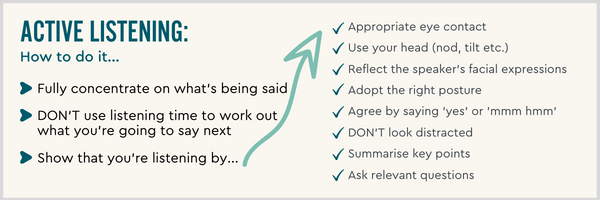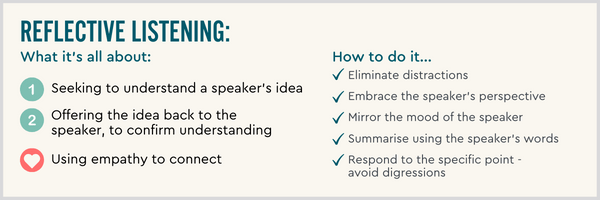
Become a communication pro through active and reflective listening
By Carolyn Quainton in Behaviour, Communication, Emotional Intelligence
Welcome back to our three-part series on communication. In our last blog post, we talked about how our poor conversational habits (e.g. judging, sending solutions and avoidance) can create communication ‘roadblocks’. This time, we’ll discuss how you can improve communication by using active and reflective listening. Let’s dive into these two different listening styles and understand how they can help you become a better communicator :).
What is active listening?
Typically, we listen passively, relying on our brains to take in the main ideas of a conversation and store them for later recall. However, this isn’t necessarily the ‘best’ way to listen. Effective communication relies on the ability to listen actively.

So, why is active listening crucial? Because when you listen carefully to your conversation partner, you demonstrate that you are interested in what they have to say. This fosters trust and makes your conversation partner feel valued. It also reduces misunderstandings, makes resolving disputes and solving problems more manageable, and creates a more encouraging environment for sharing.
What about reflective listening?
Reflective listening is a more specific strategy. This type of listening entails paying close attention to what and how someone is speaking, while also letting them know that you have heard and understood them. In this case, the listener does not comment on what the speaker has said, add their own opinions or experiences, or try to advise or solve a problem the speaker might be having.

Your goal as a reflective listener is to assist the speaker in hearing their ideas and to motivate them to continue speaking. This isn’t like other conversations, where you might listen to what the other person has to say and add new information or a connected anecdote. With reflective listening, you enable the speaker to:
- explore their emotions
- make sense of their thoughts
- decide what actions to take
Reflective listening can help to calm tense situations, resolve conflicts, and foster better interpersonal relationships.
So, how does all this help communication?
A listener can deepen their relationship and understanding with the speaker by combining these two types of listening abilities: active and reflective listening. Failure to use these skills can widen the gap between the speaker and the listener, and cause a breakdown in communication.
If you’re interested in exploring how programmes such as the Big Five can help your team communicate more effectively, we’d love to hear from you.
Talk to us, explore our website, read our blog, and follow us on LinkedIn to learn more and discover ways to grow a more successful business.


